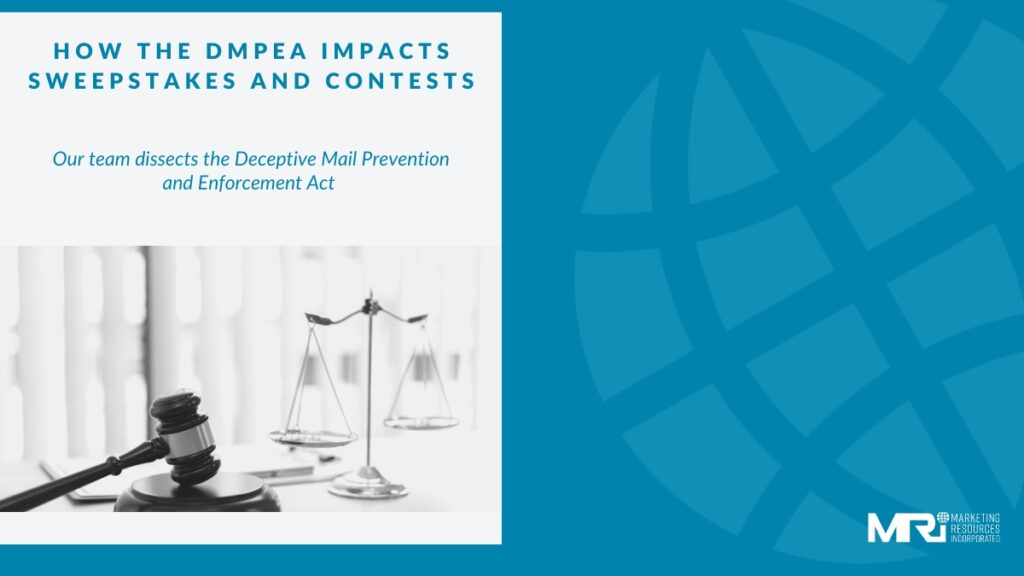Over the last 15 years, we’ve seen technological growth and digitization that dwarves the combined growth of the rest of history combined. Yet, despite this rapid digital transformation, the remains one age-old channel that isn’t going away anytime soon. Direct mail.
While it may not be used nearly as often for personal communication, everybody still gets mail every day. We’re willing to bet that most of the mail you receive is promotional in nature. Direct mail is tangible, effective marketing that still influences millions of consumers each year. In fact, according to PostGrid, 92% of millennials report being influenced by direct mail.
Because of its effectiveness, we’ve seen countless brands and partners utilize direct mail to promote their sweepstakes and contests. Who wouldn’t? Direct mail is an excellent way to bring awareness to your promotional campaign when done correctly. But, when done incorrectly, using direct mail in conjunction with your giveaway can land your brand in some serious legal trouble.
When utilizing direct mail sent via the United States Postal Service, you must be aware of the Deceptive Mail Prevention and Enforcement Act (DMPEA) passed in 1999. While this law turns 24 this year, it’s relatively unknown.
What is the Deceptive Mail Prevention and Enforcement Act
The DMPEA is a section of law passed by congress in 1999 focussed solely on “mail solicitations” by non-government entities.
In short, it sets the rules and regulations for how brands and agencies may (and may not) utilize direct mail and the United States Postal Service to promote their sweepstakes, contests, or giveaways. The law applies to any “sweepstakes mailings, skill contests, and facsimile checks” that use the United States Postal Service.
An amendment to longstanding, less severe penalties, the DMPEA was passed in the late ’90s to give the USPS greater authority over “false advertising” and allowed the agency to inflict harsher penalties on brands and agencies that participated in deceptive practices.
What Does the DMPEA Require?
Like most laws, the DMPEA’s official language is long and quite confusing. It’s no wonder so many people have never heard of it before, it’s not exactly “light reading.”
Thankfully, our team of legal experts and promotional marketers have dissected the law and break it down into digestible sections for your convenience. However, we caution you to consider hiring a promotional administrator to handle the complexities of your brand’s sweepstakes legal administration. With the risk of steep penalties and legal action, the stakes are simply too high for most brands to risk.
The DMPEA and Official Rules
First and foremost, the Deceptive Mail Prevention and Enforcement Act requires brands to disclose the following information “conspicuously” in any solicitation materials, the entry form, and in the official rules. In this case, “conspicuously” means that this information must be clear, in understandable language, and printed in a legible font.
- A statement that “no purchase is necessary to enter”
- The Alternate Method of Entry (AMOE) details
- A statement that “a purchase will not improve an individual’s chances of winning”
- Prizing details including what the prize is and its retail value
- The schedule of any payments that will be made over time
- The campaign sponsor
- The location where entrants can view the full official rules
- That the sweepstakes is subject to the complete official rules
Beyond that, the DMPEA has further regulations designed to protect consumers from false advertising that your brand must follow when promoting your sweepstakes or giveaway.
The DMPEA and False Representation
Another key element of the DMPEA to be aware of is its emphasis on the prohibition of false representation. This is the bulk of the “deceptive” part of the law.
Scattered throughout the language of the law is the fact that any sweepstakes or contests sponsors (or really anyone sending mail via the USPS) may not falsely represent themselves as any government agency.
While this may seem like a no-brainer, it’s important to note that your giveaway cannot “contain a seal, insignia, trade or brand name which could reasonably be construed as implying any Federal Government connection or endorsement.” This is both fraudulent and illegal, and is a surefire way to catch the wrong type of attention from law enforcement agencies.
On top of that, giveaway sponsors are prohibited from suggesting that their campaign will have any impact on a participant’s federal government “benefits or services.” For example, you cannot state that a failure to enter your giveaway will result in a loss of government-provided health insurance or funding.
Remove Contacts From Mailing Lists
Finally, the DMPEA requires sweepstakes and game sponsors to allow their audience to opt out of receiving sweepstakes-related mailings.
Simply put, consumers have the right to remove themselves from promotional mailing lists. The DMPEA puts the burden on the campaign sponsor to “establish and maintain a notification system that provides for an individual or other duly authorized person to notify the system of the individual’s election to have his or her name and address excluded from all lists of names and addresses used by that promoter to mail such material.” Basically, if someone doesn’t want to get promotional mail from you anymore, it’s on your brand or agency to record that and honor it.
You’ll want to make sure that whatever notification system you have in place is 100% accurate. The DMPEA empowers consumers to sue for failure to remove their names from sweepstakes mailing lists, opening your brand up to a number of lawsuits if you make a mistake here.
What Are the DMPEA Penalties?
The DMPEA defines a number of different scenarios for which a giveaway sponsor may be found in violation of the law. With each violation, the DMPEA empowers the USPS to levy various penalties and fines.
We’ve outlined them below.
Civil Penalties
Regulated by the United States Postal Service, the DMPEA amends the civil penalties section of the postal code.
It allows the USPS to fine offenders up to $1 million for the first offense, depending on the volume of mail.
- Up to $25,000 based on small quantities of up to 50,000 pieces
- $50,000 for each mailing from 50,000 to 100,000 pieces
- An additional $5,000 for each additional 10,000 pieces above 100,000, not to exceed $1 million.
DMPEA and Stop Order Penalties
Whenever the USPS believes an advertiser is practicing deceptive marketing tactics through the mail, they’ll issue what’s called a “Mail Stop Order.” Which, as you probably guessed, prohibits them from continuing that particular practice.
Before the DMPEA, the USPS could simply demand a stop order, but not impose any penalties. Now, the DMPEA allows for a $1 million penalty to accompany the stop order and allows for even steeper penalties of up to $2 million for sponsors who violate the stop order.
‘Do Not Mail’ List Penalties
We mentioned above that the Deceptive Mail Prevention and Enforcement Act allows consumers to sue for a failure to remove their name from your mailing list.
The DMPEA outlines significant penalties of up to $2 million per violation for sponsors who continue to mail to “do not mail” lists for commercial purposes.
MRi Ensures DMPEA Compliancy for Your Brand
A full-service promotional administrator, we have 30 years of experience helping brands navigate the laws regulating sweepstakes and contests, We literally pre-date the Deceptive Mail Protection and Enforcement Act, and have a perfect track record of compliance in the thousands of campaigns we’ve administered.
No matter where your brand is in the development of your sweepstakes or contest, our team is ready to help you.






